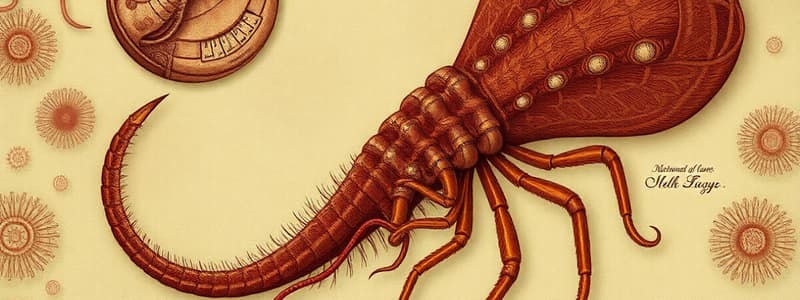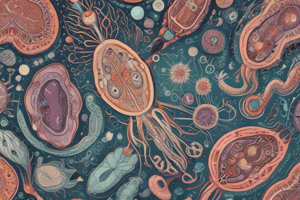Podcast
Questions and Answers
What are the two types of body structures characterized in parasitic worms mentioned in the text?
What are the two types of body structures characterized in parasitic worms mentioned in the text?
Segmented and unsegmented.
What is the most common method of transmission for parasitic infections according to the information provided?
What is the most common method of transmission for parasitic infections according to the information provided?
Oral route through contaminated food or water.
What are the infective stages mentioned that can lead to parasitic infection?
What are the infective stages mentioned that can lead to parasitic infection?
Cysts, embryonated eggs, or larval forms.
Identify one mode of transmission for parasitic diseases other than the oral route.
Identify one mode of transmission for parasitic diseases other than the oral route.
What symptom is associated with abdominal issues caused by parasitic infections?
What symptom is associated with abdominal issues caused by parasitic infections?
Which symptom indicates a possible liver-related complication from parasitic infections?
Which symptom indicates a possible liver-related complication from parasitic infections?
What condition may develop from chronic parasitic infection leading to blood issues?
What condition may develop from chronic parasitic infection leading to blood issues?
Name one potential transmission method of parasitic infection from a mother to her offspring.
Name one potential transmission method of parasitic infection from a mother to her offspring.
What is unique about the female Schistosoma compared to other flatworms?
What is unique about the female Schistosoma compared to other flatworms?
Describe the digestive system of a typical flatworm.
Describe the digestive system of a typical flatworm.
What structures are involved in the fixation of flatworms?
What structures are involved in the fixation of flatworms?
How do tapeworms differ in structure from other flatworms?
How do tapeworms differ in structure from other flatworms?
Explain the reproductive characteristics of tapeworms.
Explain the reproductive characteristics of tapeworms.
What is the primary method through which some flatworms obtain nutrients?
What is the primary method through which some flatworms obtain nutrients?
Identify the two types of body shapes seen in worms and give an example organism for each.
Identify the two types of body shapes seen in worms and give an example organism for each.
How do the sexes differ in unisexual flatworms?
How do the sexes differ in unisexual flatworms?
What role does the sexual reproduction mode of schistosomes play in their life cycle?
What role does the sexual reproduction mode of schistosomes play in their life cycle?
How does the morphology of adult parasitic worms affect their habitat within the host?
How does the morphology of adult parasitic worms affect their habitat within the host?
Describe how the mode of arthropod transmission relates to the life cycle of filarial worms.
Describe how the mode of arthropod transmission relates to the life cycle of filarial worms.
What is the significance of abdominal symptoms associated with parasitic infections?
What is the significance of abdominal symptoms associated with parasitic infections?
How does the transmission of Toxocara from mother dog to puppies exemplify maternal transmission?
How does the transmission of Toxocara from mother dog to puppies exemplify maternal transmission?
Discuss the importance of environmental factors in the transmission of parasitic infections.
Discuss the importance of environmental factors in the transmission of parasitic infections.
Explain why many parasitic infections exhibit symptoms such as fevers and jaundice.
Explain why many parasitic infections exhibit symptoms such as fevers and jaundice.
What is the relationship between vitamin deficiencies and chronic parasitic infections?
What is the relationship between vitamin deficiencies and chronic parasitic infections?
What distinguishes the body structure of Schistosoma from other flatworms?
What distinguishes the body structure of Schistosoma from other flatworms?
List two organs of fixation found in tapeworms and explain their functions.
List two organs of fixation found in tapeworms and explain their functions.
Describe the primary nutritional acquisition method employed by flatworms.
Describe the primary nutritional acquisition method employed by flatworms.
What characterizes the reproductive features of mature segments in tapeworms?
What characterizes the reproductive features of mature segments in tapeworms?
How does the body cavity differ between flatworms and tapeworms?
How does the body cavity differ between flatworms and tapeworms?
Explain the structure of the digestive system in unisexual flatworms compared to hermaphroditic flatworms.
Explain the structure of the digestive system in unisexual flatworms compared to hermaphroditic flatworms.
What are the three types of segments found in tapeworms, and what are their characteristics?
What are the three types of segments found in tapeworms, and what are their characteristics?
Discuss the significance of bilateral symmetry in flatworms.
Discuss the significance of bilateral symmetry in flatworms.
Flashcards
Flatworms
Flatworms
A type of flatworm with a flattened, leaf-like body structure. They lack a body cavity and are unsegmented.
Roundworms
Roundworms
A type of flatworm that has a cylindrical, rounded body structure with a body cavity. They are unsegmented and have separate sexes.
Flukes
Flukes
A type of flatworm that is flattened dorso-ventrally, has no body cavity, and is unsegmented. They have organs of fixation like oral and ventral suckers.
Tapeworms
Tapeworms
Signup and view all the flashcards
Organs of fixation
Organs of fixation
Signup and view all the flashcards
Scolex
Scolex
Signup and view all the flashcards
Strobila
Strobila
Signup and view all the flashcards
Hermaphrodites
Hermaphrodites
Signup and view all the flashcards
Parasitic Worm Classification
Parasitic Worm Classification
Signup and view all the flashcards
Monoecious vs. Diecious Parasites
Monoecious vs. Diecious Parasites
Signup and view all the flashcards
Parasite Lifecycle
Parasite Lifecycle
Signup and view all the flashcards
Oral Route Transmission
Oral Route Transmission
Signup and view all the flashcards
Insect Bite Transmission
Insect Bite Transmission
Signup and view all the flashcards
Person-to-Person Transmission
Person-to-Person Transmission
Signup and view all the flashcards
Mother-to-Fetus Transmission
Mother-to-Fetus Transmission
Signup and view all the flashcards
Common Symptoms of Parasitic Infections
Common Symptoms of Parasitic Infections
Signup and view all the flashcards
Tape-like Worms
Tape-like Worms
Signup and view all the flashcards
Unsegmented Worms
Unsegmented Worms
Signup and view all the flashcards
Monoecious Parasite
Monoecious Parasite
Signup and view all the flashcards
Diecious Parasite
Diecious Parasite
Signup and view all the flashcards
What are flatworms?
What are flatworms?
Signup and view all the flashcards
What are flukes?
What are flukes?
Signup and view all the flashcards
What are the characteristics of flukes?
What are the characteristics of flukes?
Signup and view all the flashcards
What are tapeworms?
What are tapeworms?
Signup and view all the flashcards
What is the scolex of a tapeworm?
What is the scolex of a tapeworm?
Signup and view all the flashcards
What is the strobila of a tapeworm?
What is the strobila of a tapeworm?
Signup and view all the flashcards
What are roundworms?
What are roundworms?
Signup and view all the flashcards
What is the digestive system of a roundworm?
What is the digestive system of a roundworm?
Signup and view all the flashcards
Study Notes
Parasitology - Lecture 2: Helminthology
- Helminths are classified into Platyhelminths (flatworms) and Nematodes (roundworms)
- Platyhelminths further divided into Cestodes (tapeworms) and Trematodes (flukes)
- Nematodes are elongated and cylindrical
- Cestodes are segmented and lack a body cavity. They have a scolex (head) with suckers or hooks for attachment and strobila (body) made of proglottids (segments)
- Trematodes are leaf-like, and have a ventral and oral sucker for attachment and a complex digestive system.
- Some are hermaphrodites (both sexes in one individual) except for some like Schistosoma.
- Trematodes have an oral sucker, a ventral sucker, spines (for fixation), a mouth, esophagus and intestinal caeca
- Nematodes are cylindrical, have a body cavity, are unsegmented, and have separate sexes (most)
- Cestodes absorb nutrients through their body surface, not through a digestive system
- Different helminths have different life cycles and require different intermediate hosts. Some need snails, crustaceans, or insects.
- Modes of transmission include oral ingestion, skin penetration, vector transmission (like mosquitoes), and direct transmission (person-to-person contact).
- Symptoms of helminth infections vary depending on the parasite and its location in the body. Symptoms can include abdominal colic, diarrhea, vomiting, loss of appetite, weight loss, vitamin deficiencies, fever, right hypochondrium pain, jaundice, hepatomegaly, chest pain, cough, dyspnea (difficulty breathing), hemoptysis (coughing up blood), respiratory failure, hepatosplenomegaly, esophageal varices, hematemesis (vomiting blood), melena (black stool), and elephantiasis.
- Diagnosis involves clinical picture, laboratory diagnosis (e.g., stool examination, sputum examination), and radiological diagnosis (e.g., X-ray, CT scan, or MRI) to detect eggs, segments or larvae.
- Serological testing detects antibodies, and skin tests can also be used to detect certain helminths.
Helminth Classification and Characteristics
- Cestodes (tapeworms): segmented worms, no body cavity, absorb nutrients through body surface
- Trematodes (flukes): flattened, leaf-like, have suckers, complex digestive system, some hermaphroditic (both sexes)
- Nematodes (roundworms): cylindrical, unsegmented, have a body cavity, separate sexes
Helminth Life Cycles
- Life cycles involve different stages: eggs, larva, and adult.
- Some helminths require intermediate hosts (like snails, crustaceans, or insects) before reaching the definitive host. Specific examples of intermediate hosts are mentioned in each description and should be noted in studying each example.
Modes of Transmission
- Oral transmission (contaminated food or water)
- Skin penetration
- Vector transmission (e.g., mosquito bite)
- Direct transmission (person-to-person)
- Vertical transmission (mother to fetus)
Clinical Presentations and Diagnosis
- Symptoms vary based on the parasite and location.
- Diagnostic methods include clinical picture, laboratory tests, and radiological imaging.
- Direct methods like stool or sputum examination can identify specific parasites.
- Indirect methods like serological testing or skin tests can find antibodies to helminths. This is for specific diagnoses and is different from just detecting antibodies in the blood.
Studying That Suits You
Use AI to generate personalized quizzes and flashcards to suit your learning preferences.




